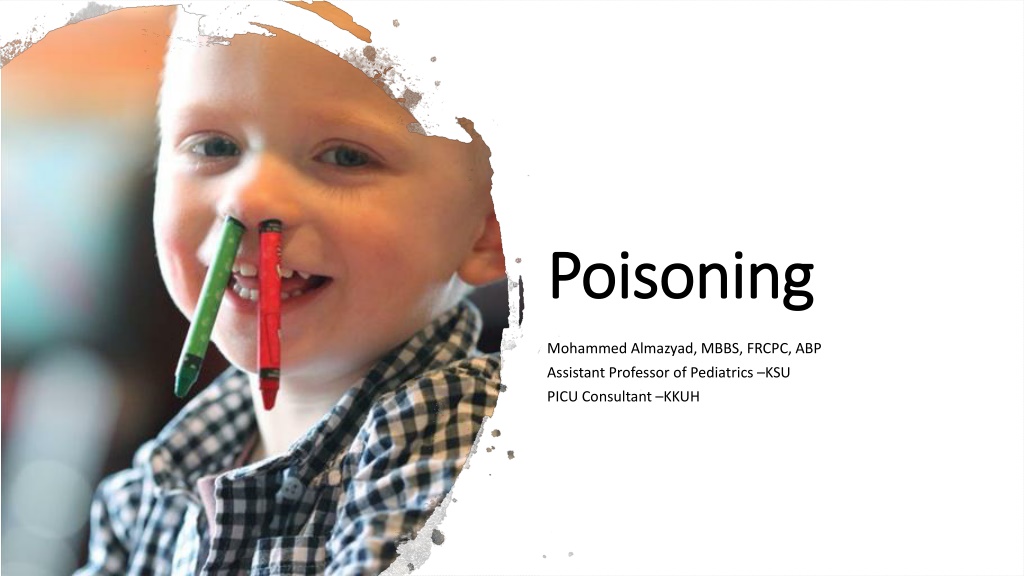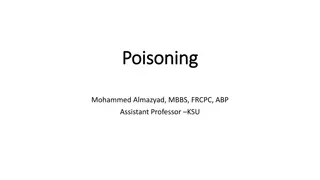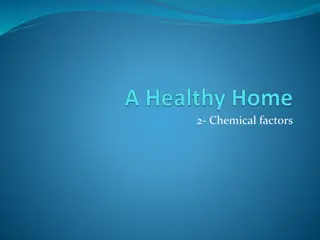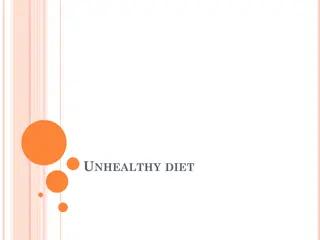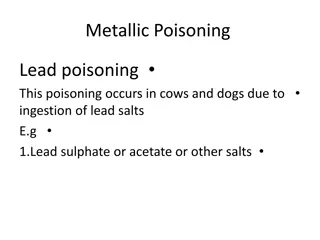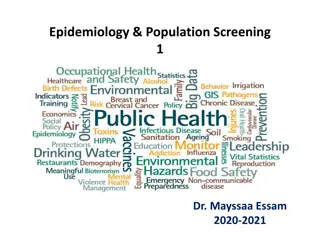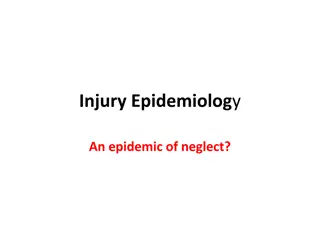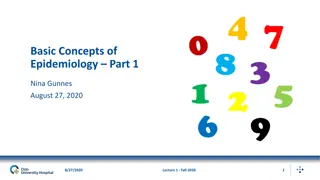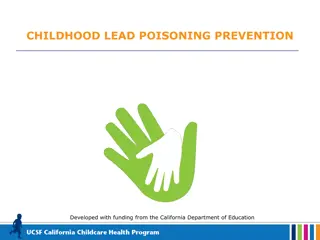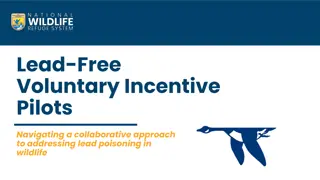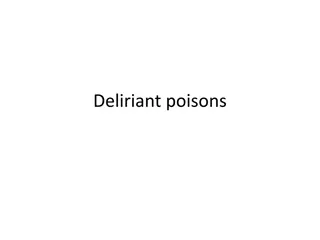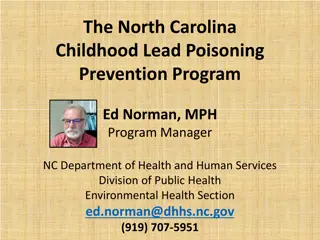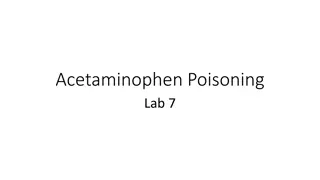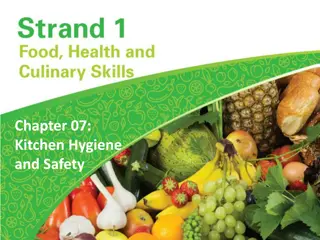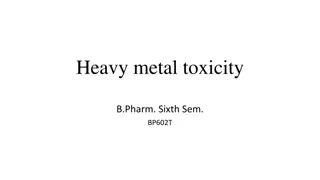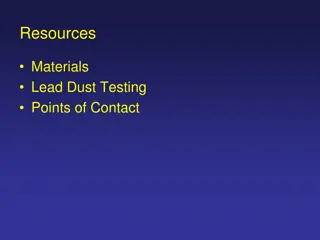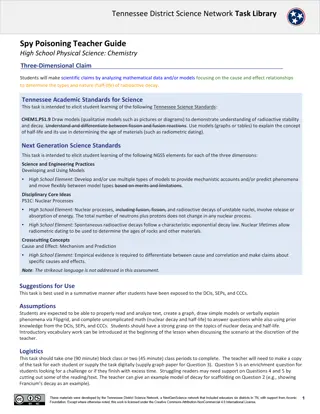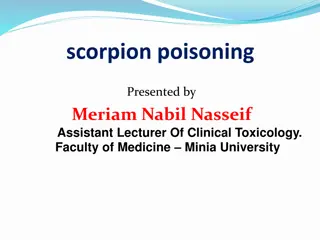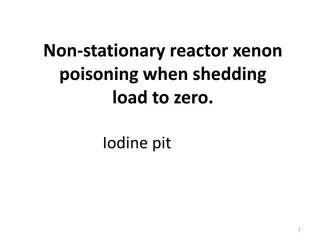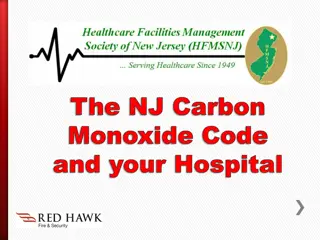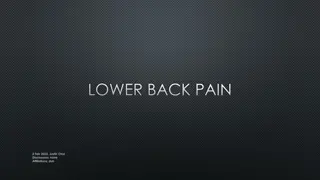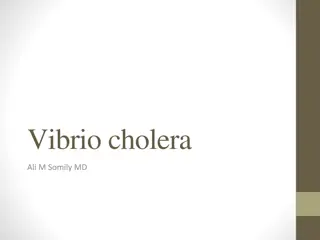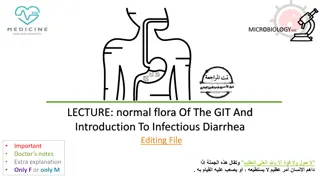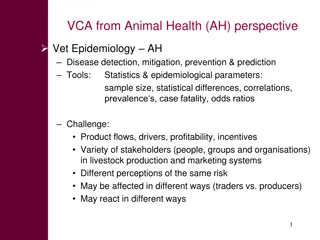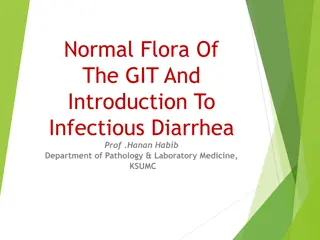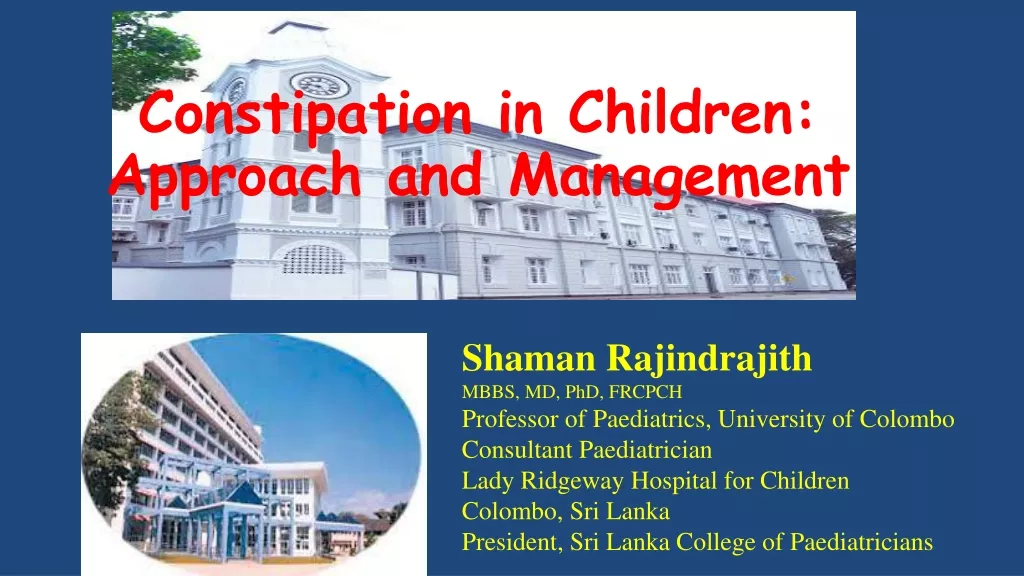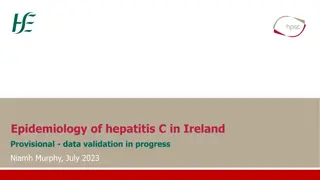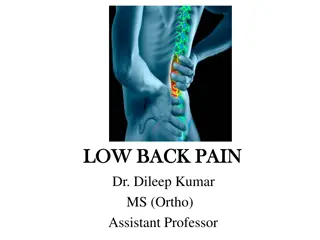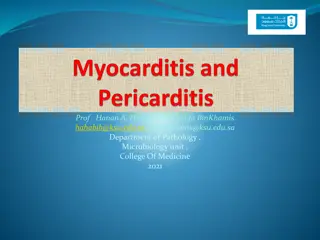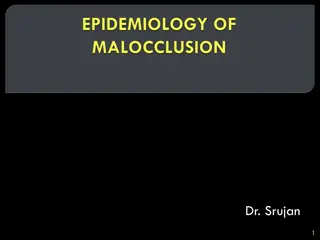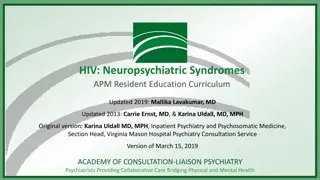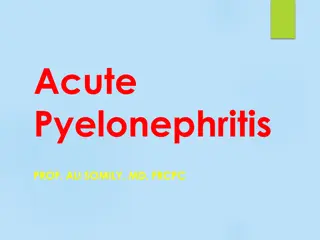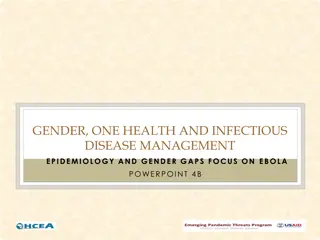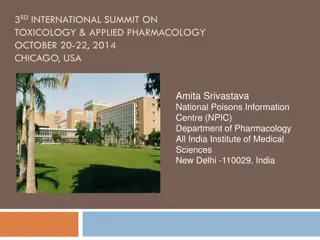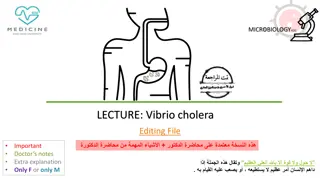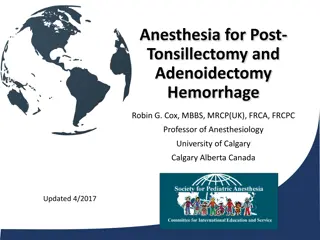Approach to Poisoning in Children: Epidemiology, History, and Management
Epidemiology of poisoning in children, including common causes and age distribution, is discussed. The approach to poisoned children involves stabilization, targeted history taking, and examination to identify potential toxins and assess the severity of poisoning. Key aspects of history include onset of symptoms, exposure details, medical history, and social factors. Must also consider toxidromes and principles of management.
Uploaded on Oct 06, 2024 | 0 Views
Download Presentation

Please find below an Image/Link to download the presentation.
The content on the website is provided AS IS for your information and personal use only. It may not be sold, licensed, or shared on other websites without obtaining consent from the author. Download presentation by click this link. If you encounter any issues during the download, it is possible that the publisher has removed the file from their server.
E N D
Presentation Transcript
Poisoning Poisoning Mohammed Almazyad, MBBS, FRCPC, ABP Assistant Professor of Pediatrics KSU PICU Consultant KKUH
Objectives Objectives Epidemiology Approach to the poisoned child Hx Physical exam Lab/Diagnostic tests Toxidromes Principles of management
Epidemiology Epidemiology The number 1 cause of injury death in the United States. Mostly unintentional. CO and analgesics were the leading causes of poison-related fatalities in young children 50% occur in children younger than 6yr old. Poisoning exposures in children 6-12yr old are much less common(2%) A second peak in pediatric exposures occurs in adolescence (intentional) Children younger than 6yr account for <2% of all poisoning fatalities
Epidemiology Epidemiology Where/how/what Where/how/what ? Related to newly designed safety packages 90% of toxic exposures in children occur in the home. Most involve only a single substance Ingestion most common rout 50% of cases involve are nondrug Household cleaning products and cosmetics represent the majority of calls to poison centers
Approach Approach Should be no different than that in any other sick child. Stabilization and ABCDEs Targeted history and physical examination
Approach Approach History History Very important Some features may suggest poisoning Acute onset No prodrome Sudden change in LOC Multiorgan failure Description of the exposure: When, how much , where , why What (household product vs medical) List of meds in house Did the family brought it the product with them? immediate- versus extended-release preparation
Approach Approach History History Details of the symptoms When did the symptom start in relation to time of ingestion Progression Past Medical History: Underlying diseases can make a child susceptible to the effects of a toxin. Current medication list (Drug-Drug interaction) Psychiatric illness (more prone to substance abuse, misuse, intentional ingestions, and polypharmacy complications) A developmental history (a report of a 6 mo old picking up a large container of laundry detergent and drinking it should raise a red flag) Social History
Approach Approach Physical Exam Physical Exam Targeted aiming to identify potential toxin and assess the severity. Findings might suggest a toxidrome and help to build a DDx Initial effort should be directed to ABCs Key features of the physical exam: V/S LOC/GCS Pupils Nystagmus Skin Bowl sounds Odor
Overview of some physical Overview of some physical findings findings
ODOR Bitter almonds Cyanide Acetone Isopropyl alcohol, methanol, paraldehyde, salicylates Alcohol Ethanol Wintergreen Methyl salicylate Garlic Arsenic, thallium, organophosphates, selenium
OCULAR SIGNS Miosis Opioids (except propoxyphene, meperidine, and pentazocine), organophosphates and other cholinergics, clonidine, phenothiazines, sedative hypnotics, olanzapine Mydriasis Anticholinergics (e.g., antihistamines, TCAs, atropine), sympathomimetics (cocaine, amphetamines, PCP) postanoxic encephalopathy, opiate withdrawal Nystagmus Anticonvulsants, sedative hypnotics, alcohols, PCP, ketamine, dextromethorphan Lacrimation Organophosphates, irritant gas or vapors Retinal hyperemia Methanol
CUTANEOUS SIGNS Diaphoresis Cholinergics (organophosphates), sympathomimetics, withdrawal syndromes Alopecia Thallium, arsenic Erythema Boric acid, elemental mercury, cyanide, carbon monoxide, disulfiram, scombroid, anticholinergics, vancomycin Cyanosis (unresponsive to oxygen) Methemoglobinemia (e.g., benzocaine, dapsone, nitrites, phenazopyridine), amiodarone, silver
ORAL SIGNS Salivation Organophosphates, salicylates, corrosives, ketamine, PCP, strychnine Oral burns Corrosives, oxalate-containing plants Gum lines Lead, mercury, arsenic, bismuth GASTROINTESTINAL SIGNS Diarrhea Antimicrobials, arsenic, iron, boric acid, cholinergics, colchicine, opioidwithdrawal Hematemesis Arsenic, iron, caustics, NSAIDs, salicylates
CARDIAC SIGNS Tachycardia Sympathomimetics, anticholinergics, antidepressants, antipsychotics, methylxanthines (theophylline, caffeine), salicylates, cellular asphyxiants (cyanide, carbon monoxide, hydrogen sulfide), withdrawal (ethanol, sedatives, clonidine, opioids), serotonin syndrome, neuroleptic malignant syndrome Bradycardia Blockers, calcium channel blockers, digoxin, clonidine, organophosphates, opioids, sedative hypnotics Hypertension Sympathomimetics, anticholinergics, monoamine oxidase inhibitors, serotonin syndrome, neuroleptic malignant syndrome, clonidine withdrawal Hypotension Blockers, calcium channel blockers, cyclic antidepressants, iron, antipsychotics, barbiturates, clonidine, opioids, arsenic, amatoxin mushrooms, cellular asphyxiants (cyanide, carbon monoxide, hydrogen sulfide), snake envenomation
RESPIRATORY SIGNS Depressed respirations Opioids, sedative-hypnotics, alcohol, clonidine, barbiturates Tachypnea Salicylates, sympathomimetics, caffeine, metabolic acidosis, carbon monoxide, hydrocarbon aspiration CENTRAL NERVOUS SYSTEM SIGNS Ataxia Alcohols, anticonvulsants, sedative hypnotics, lithium, dextromethorphan, carbon monoxide, inhalants Coma Opioids, sedative hypnotics, anticonvulsants, antidepressants, antipsychotics, ethanol, anticholinergics, clonidine, GHB, alcohols, salicylates, barbiturates Seizures Sympathomimetics, anticholinergics, antidepressants (especially TCAs, bupropion, venlafaxine), cholinergics (organophosphates), isoniazid, camphor, lindane, salicylates, lead, nicotine, tramadol, water hemlock, withdrawal Delirium/psychosis Sympathomimetics, anticholinergics, LSD, PCP, hallucinogens, lithium, dextromethorphan, steroids, withdrawal Peripheral neuropathy Lead, arsenic, mercury, organophosphates
Toxidromes Toxidromes Definition: A group of signs and symptoms constituting the basis for a diagnosis of poisoning.
Sympathomimetic Sympathomimetic TOXIDROME SIGNS POSSIBLE TOXINS VITAL SIGNS MENTAL STATUS PUPILS SKIN BOWEL SOUNDS OTHER Sympathomim etic Hypertension, tachycardia, hyperthermia Agitation, psychosis, delirium, violence Dilated Diaphoretic Normal to increased Amphetamine s, cocaine, PCP, bath salts (cathinones), ADHD medication
Anticholinergic Anticholinergic TOXIDROME SIGNS POSSIBLE TOXINS VITAL SIGNS MENTAL STATUS PUPILS SKIN BOWEL SOUNDS OTHER Anticholinergic Hypertensio Agitated, delirium, coma, seizures Dilated Dry, hot Diminished Ileus urinary retention Antihistamin es, tricyclic antidepressa nts, atropine, jimson weed n, tachycardia, hyperthermi a
Anticholinergic Anticholinergic
Cholinergic Cholinergic TOXIDROME SIGNS POSSIBLE TOXINS VITAL SIGNS MENTAL STATUS PUPILS SKIN BOWEL SOUNDS OTHER Cholinergic Bradycardia BP and temp typically normal Confusion, coma, fasciculation s Small Diaphoretic Hyperactive Diarrhea, urination, bronchorrhe a, bronchospas m, emesis, lacrimation, salivation Organophos phates (insecticides, nerve agents), carbamates (physostigmi ne, neostigmine, pyridostigmi ne)
Cholinergic Cholinergic
Opioids Opioids TOXIDROME SIGNS POSSIBLE TOXINS VITAL SIGNS MENTAL STATUS PUPILS SKIN BOWEL SOUNDS OTHER Opioids Respiratory depression bradycardia, hypotension, hypothermia Depression, coma, euphoria Pinpoint Normal Normal to decreased Methadone, buprenorphi ne, morphine, oxycodone, heroin, etc.
Opioids Withdrawal Opioids Withdrawal TOXIDROME SIGNS POSSIBLE TOXINS VITAL SIGNS MENTAL PUPILS SKIN BOWEL SOUNDS OTHER STATUS Withdrawal (opioid) Tachycardia Restlessness, anxiety Dilated diaphoretic Hyperactive Nausea, vomiting, diarrhea Lack of access to opioids or excessive use of naloxone
Serotonin Syndrome Serotonin Syndrome TOXIDROME SIGNS POSSIBLE TOXINS VITAL SIGNS MENTAL PUPILS SKIN BOWEL SOUNDS OTHER STATUS Serotonin syndrome Hyperthermi a, tachycardia, hypertensio n or hypotension (autonomic instability) Agitation, confusion, coma Dilated Diaphoretic Increased Neuromuscu lar hyperexcitab ility: clonus, hyperreflexia (lower extremities > upper extremities) SSRIs, lithium, MAOIs, linezolid, tramadol, meperidine, dextrometho rphan
Serotonin Syndrome Serotonin Syndrome
Lab/Diagnostic Testing Lab/Diagnostic Testing Drug Levels Tox-Screen U&E Blood Gas LFTs (Acetaminophen) Serum Osmolality (Alcohol) CK (prolonged down time) ECG (Dig, Amiodaron, SSRI)
Drug levels Drug levels For some drugs quantitative blood concentrations are integral to confirming the diagnosis and formulating a treatment plan. SAS, Acetaminophen, dig, iron and methanol. For most exposures, quantitative measurement is not readily available and is not likely to alter management. All intoxicant levels must be interpreted in conjunction with the history. Chronic vs acute use Time of ingestion Co-ongestion
Acetaminophen Level Acetaminophen Level Very helpful. Acetaminophen is a widely available medication and a commonly detected co-ingestant with the potential for severe toxicity. There is an effective antidote to acetaminophen poisoning that is time- dependent. Patients might initially be asymptomatic and might not report acetaminophen as a coingestant, an acetaminophen level should be checked in all patients who present after an intentional exposure or ingestion
Tox Tox- -Screen Screen Varey from lab to lab : What it tests for? Cutoff for + False + /Fales Eg Synthetic opioid are not detected with urine tox-screen Helpful in patients with altered mental status of unknown etiology, persistent, unexplained tachycardia, acute myocardial ischemia or stroke at a young age
KUB KUB RADIOPAQUE SUBSTANCE ON KUB (MNEMONIC = CHIPPED) C hloral hydrate, calcium carbonate H eavy metals (lead, zinc, barium, arsenic, lithium, bismuth) I ron P henothiazines P lay-Doh, potassium chloride E nteric-coated pills D ental amalgam, drug packets
Principles of Management Principles of Management 1. ABCDs (supportive care) 2. Antidots 3. Decontamination 4. Enhanced elimination
ABCDs (supportive care) ABCDs (supportive care) Airway: Patent and maintainable Breathing: Spontaneous with GABL ,RR, SpO2 and WOB Circulation: HR, BP, Cap refill, Rhythm and Liver edge in infants Disability: Pupils ?equal and reactive . GCS Glucocheck Exposure , check the skin for any contamination
Antidots Antidots Definition = a medicine taken or given to counteract a particular poison. Only a small proportion of poisoned patients are amenable to antidotal therapy Only a few poisoning is antidotal therapy urgent (e.g., CO, cyanide, organophosphate and opioid intoxication)
POISON ANTIDOTE DOSAGE ROUTE ADVERSE EFFECTS, WARNINGS, COMMENTS Acetaminophen N -Acetylcysteine (Mucomyst) 140mg/kg loading, followed by 70mg/kg q4h PO Vomiting (patient-tailored regimens are the norm) N -Acetylcysteine (Acetadote) 150mg/kg over 1hr, followed by 50mg/kg over 4hr, followed by 100mg/kg over 16hr IV Anaphylactoid reactions (most commonly seen with loading dose) (Higher doses of the infusion are often recommended depending upon the acetaminophen level and the degree of injury) Anticholinergics Physostigmine 0.02mg/kg over 5min; may repeat q5-10min to 2mg max IV/IM Bradycardia, seizures, bronchospasm Note: Do not use if conduction delays on ECG Benzodiazepines Flumazenil 0.2mg over 30sec; if response is inadequate, repeat q1min to 1mg max IV Agitation, seizures; do not use for unknown ingestions Blockers Glucagon 0.15mg/kg bolus followed by infusion of 0.05- 0.15mg/kg/hr IV Hyperglycemia, vomiting
POISON ANTIDOTE DOSAGE ROUTE ADVERSE EFFECTS, WARNINGS, COMMENTS Carbon monoxide Oxygen 100% F io 2 via non rebreather mask (or ET if intubated) Inhalational Some patients may benefit from hyperbaric oxygen (see text) Cyanide Cyanide kit: Amyl nitrate 1 crushable ampule; inhale 30sec of each min Inhalation Methemoglobinemia Sodium nitrate 0.33mL/kg of 3% solution if hemoglobin level is not known; otherwise, based on tables with product IV Methemoglobinemia Hypotension Sodium thiosulfate 1.6mL/kg of 25% solution; may be repeated q30-60min to max of 50mL IV If inducing methemoglobinemia is contraindicated; consider only using the thiosulfate component of the kit Hydroxocobalamin (Cyanokit) 70mg/kg (adults: 5g) given over 15min IV Flushing/erythema, nausea, rash, chromaturia, hypertension, headache Digitalis Digoxin-specific Fab antibodies (Digibind; DigiFab) 1 vial binds 0.6 mg of digitalis glycoside; #vials = digitalis level weight in kg/100 IV Allergic reactions (rare), return of condition being treated with digitalis glycoside
POISON ANTIDOTE DOSAGE ROUTE ADVERSE EFFECTS, WARNINGS, COMMENTS Opioids Naloxone 0.01-0.1mg/kg; adolescents/adults: 0.04- 2mg, repeated as needed; may give continuous infusion IV Acute withdrawal symptoms if given to addicted patients May also be useful for clonidine ingestions (inconsistent response) Organophosphates Atropine 0.05-0.1mg/kg repeated q5-10min as needed IV/ET Tachycardia, dry mouth, blurred vision, urinary retention Pralidoxime (2-PAM) 25-50mg/kg over 5-10min (max: 200mg/min); can be repeated after 1-2hr, then q10-12hr as needed IV/IM Nausea, dizziness, headache, tachycardia, muscle rigidity, bronchospasm (rapid administration)
POISON ANTIDOTE DOSAGE ROUTE ADVERSE EFFECTS, WARNINGS, COMMENTS Ethylene glycol, methanol Fomepizole 15mg/kg load; 10mg/kg q12h 4 doses; 15 mg/kg q12h until EG level is <20mg/dL IV Infuse slowly over 30min; If fomepizole is not available, can treat with oral ethanol (80 proof) Iron Deferoxamine Infusion of 5- 15mg/kg/hr (max: 6g/24hr) IV Hypotension (minimized by avoiding rapid infusion rates) Isoniazid (INH) Pyridoxine Empirical dosing: 70mg/kg (max dose = 5g) If ingested dose is known: 1g per gram of INH IV May also be used for Gyromitra mushroo m ingestions
Decontamination Decontamination The goal of decontamination is to minimize absorption of the toxic substance. Decontamination should not be routinely employed for every poisoned patient. Dermal and ocular decontamination remove any contaminated clothing and particulate matter, followed by flushing of the affected area with tepid water or normal saline. 10-20 min of washing is recommended for most exposures. Dermal decontamination, especially after exposure to adherent or lipophilic (e.g., organophosphates) agents, should include thorough cleansing with soap and water . Avoid water with highly reactive agents.
GI Decontamination: GI Decontamination: GI decontamination strategies are most likely to be effective in the 1st hour after an acute ingestion. GI decontamination at more than 1 hr after ingestion may be considered in patients who ingest toxic substances with these properties: GI absorption may be delayed after ingestion of agents that slow GI motility (anticholinergic medications, opioids or TCA). massive pill ingestions. sustained-release preparations. ingestions of agents that can form pharmacologic bezoars (e.g., enteric-coated salicylates).
Methods of Methods of GI Decontamination: GI Decontamination: Syrup Ipecac: Risk is more than benefit (no evidence) Gastric Lavage: in most clinical scenarios, the use of gastric lavage is no longer recommended.
Single dose Activated Charcoal: Single dose Activated Charcoal: It has an extensive network of pores that provides a very large adsorptive surface area. 1g/kg or 50-100 g in adolescents and adults A repeat dose of activated charcoal may be warranted in the cases of ingestion of an extended release product or, more commonly, with a significant salicylate poisoning as a result of its delayed and erratic absorption pattern. Not effective in : Charged molecules (i.e., heavy metals lithium, iron) liquids do not bind well to activated charcoal Caustic agents
Single dose Activated Charcoal: Single dose Activated Charcoal: 20% of pt will vomit must ensure that the patient s airway is intact or protected and that the patient has a benign abdominal exam. In the awake, uncooperative adolescent or child who refuses to drink the activated charcoal, there is relatively little utility and potential morbidity associated with forcing activated charcoal down a nasogastric tube, and such practice should be avoided. Constipation is a common side effect. ( consider lactulose)
Enhanced Elimination: Enhanced Elimination: Urinary Alkalinization Hemodialysis Multiple-Dose Activated Charcoal Intralipid Emulsion Therapy
Urinary Urinary Alkalinization Alkalinization Making a molecule charged and hydrophilic difficult to be absorbed through fat membrane Thus, the molecule is trapped within the renal tubules Accomplished via a continuous infusion of sodium bicarbonate containing intravenous fluids, with a goal urine pH of 7.5-8. Alkalinization of the urine is most useful in managing salicylate and methotrexate toxicity.
Hemodialysis Enhance the elimination of the toxin itself Also be useful to correct severe electrolyte disturbances and acid base derangement Toxins that are amenable to dialysis have the following properties: low volume of distribution (<1 L/kg). low molecular weight. low degree of protein binding. high degree of water solubility. eg methanol, ethylene glycol, salicylates, theophylline, bromide, lithium, and, potentially, valproic acid.
Acetaminophen Acetaminophen The most common cause of acute liver failure in USA The single acute toxic dose of acetaminophen is generally considered to be >200 mg/kg in children and >7.5-10 g in adolescents and adults.
Classical signs and symptoms Classical signs and symptoms T after Ingestion CHARACTERISTICS STAGE I 0.5 24 hr Anorexia, nausea, vomiting, malaise, pallor, diaphoresis II 24 48 hr Resolution of earlier symptoms; right upper quadrant abdominal pain and tenderness; elevated bilirubin, prothrombin time, hepatic enzymes; oliguria III 72 96 hr Peak liver fxn abnormalities; anorexia, nausea, vomiting, and malaise may reappear IV 4 days 2 wk Resolution of hepatic dysfunction or complete liver failure
Acetaminophen Acetaminophen
Acetaminophen overdose Rx Acetaminophen overdose Rx After ABCs Hx Time Quantity Regular vs extended rlease Intetion LFTs, Lytes, renal function Obtain a level 4 hours after ingestion Use Rumack-Matthew nomogram Only for single ingestion
